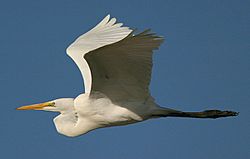Great Egret facts for kids
Quick facts for kids Great Egret |
|
|---|---|
 |
|
| Great Egret | |
| Conservation status | |
| Scientific classification | |
| Kingdom: | |
| Phylum: | |
| Class: | |
| Order: | |
| Family: | |
| Genus: | |
| Species: |
A. alba
|
| Binomial name | |
| Ardea alba |
|
| Synonyms | |
|
|
The Great Egret (also called the Common Egret) is a big, white bird that loves to wade in water. You can find these beautiful birds all over the world!
It's the second-biggest bird in the heron family in America, right after the Great Blue Heron. Great Egrets like to live in muddy areas, shallow waters, and marshes. During winter, many fly south to places like Colombia. When they fly, their wing beats are slow and graceful. They also have a deep, croaking call.
The scientific name for the Great Egret is Ardea alba. This name tells us its genus and species.
What Great Egrets Eat
Great Egrets are skilled hunters! They eat many different things, including fish, lizards, frogs, crayfish, small rodents, and insects.
They often hunt in shallow water. They use their long, sharp bills to quickly catch their prey. It's like spearing their food!
Eggs and Nests
Great Egrets build their nests from twigs and sticks. These nests are like platforms and can be found in trees or sometimes on the ground.
Female egrets usually lay 3 to 5 pale blue-green eggs at one time. This group of eggs is called a clutch. The eggs hatch after about 23 to 26 days.
Images for kids
-
Adult sitting on a bridge in California
-
Great egret during mating season at High Island
-
Great egret at Centennial Lakes Park in Edina, Minnesota
-
Stuffed specimens at the American Museum of Natural History
-
Plunging its head into the water to hunt inside Green-Wood Cemetery in Brooklyn
-
Adult in flight over Lake Coatepeque, El Salvador
See also
 In Spanish: Garceta grande para niños
In Spanish: Garceta grande para niños

















